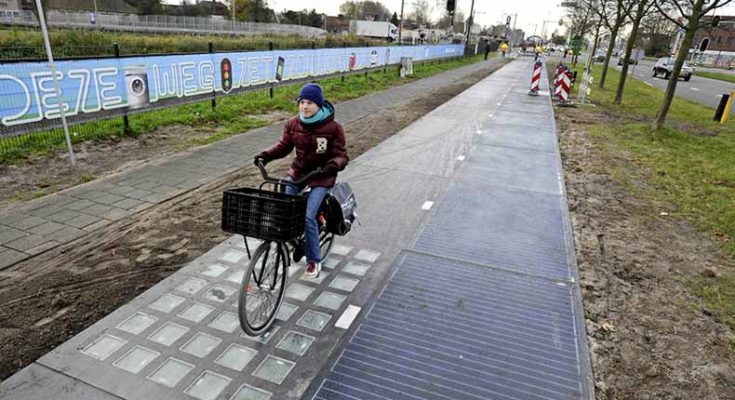Netherlands initiated world’s first Solar Bike Path. Image Courtesy – https://www.rte.ie
The Netherlands unveiled a 230-foot bicycle path that is developed with solar panels. The bicycle way, which was inaugurated on 12th November, 2014 was the first openly available sun powered street on the planet.
The pilot bicycle path is simply a little section of a way the runs along a commonplace street in the town of Krommenie, which is approximately 15 miles north of Amsterdam. The bicycle way was manufactured utilizing square solid modules fitted with sunlight based cells. Layer of 1 centimetre thick treated glass fits over the highest point of the cells.
In spite of the fact that the boards may sound sensitive, they can deal with the weight and weight of a bicycle without breaking. As the boards are in a settled position, they produce 30 percent less vitality than those introduced on housetops. To maximize effect of the sun based way, boards were introduced on points to let the downpour wash off earth.
Read: ZenWatch by Asus created a new era of tech-style
The Netherlands Organization for Applied Scientific Research (TNO) led the $3.74-million venture, named the Solaroad. The arrangement is to develop the bicycle way to 328 feet by 2016. The way ought to create enough power to light three homes.
Presently, researchers will screen the bicycle way for a three-year period, taking estimations and performing tests along the way. They basically need to decide how much power the street really produces, how it stands up to the riders around 2,000 every day.
Stan de Wit, of The Netherlands Organization for Applied Scientific Research, accepted that up to 20% of the Netherlands’ 87,000 miles of roads could be solar-powered. The sunlight based streets could possibly power anything from traffic lights to electric autos.
Read: Counting of calorie is possible now from food photo
While Krommenie will turn into the first group on the planet with a freely open stretch of sun based street, the thought of utilizing existing street framework to collect sun powered vitality is picking up force over the globe.
Idaho couple Julie and Scott Brusaw, the two US engineers, have been creating solar panels to use in roads since 2006. Their organization, Solar Roadways, got an agreement from America’s Federal Highway Administration to manufacture for a model in the year 2009.
The Brusaws supplanted their own particular parking area with sunlight based panelled units in March, 2014, and on account of a prominent viral feature, they have raised $2.2m (£1.4m) to put their configuration into generation.
The Solar Roadways website of US stated that their country would produce energy three times more than the present situation and simultaneously would reduce 75% of greenhouse gases.





